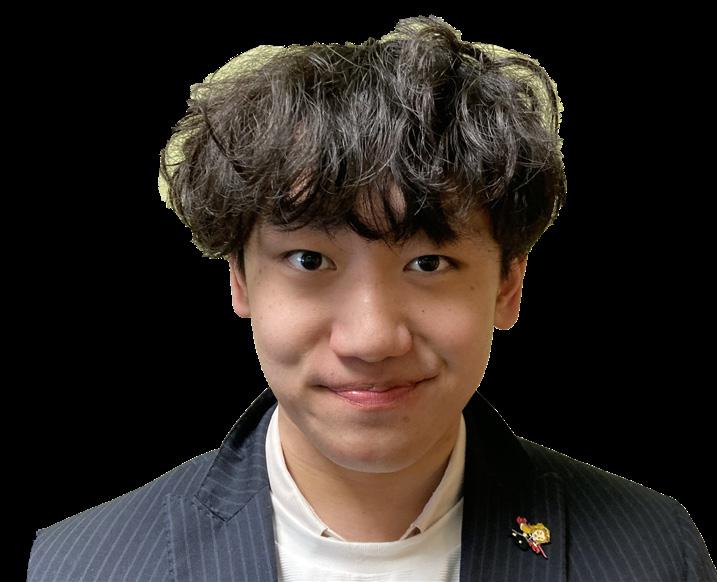
32 minute read
Lunar New Year should be a school holiday
campus opinions
Dylan Kao ’23
Advertisement
Imagine this: your family is celebrating the largest holiday in your culture, and you’re about to reunite with family you haven’t seen for a while. You plan to celebrate by eating lots of food and socializing with your family; but you can’t because you have a 20-page history reading, a six-page English essay, and you have to study for a biology test, all of which are due tomorrow. Though this scenario is exaggerated a bit, nothing leaves more of a bitter taste in your mouth than doing loads of homework while the rest of your household is celebrating. This is how it is for Asian students in America, Lunar New Year, sometimes called Chinese New Year, is not a federally recognized holiday in the United States, nor is it recognized here at The Haverford School.
Lunar New Year is celebrated by over one billion people worldwide. It’s the most important holiday in Chinese culture. The New Year is based on the Chinese lunar calendar, or more simply, the final new moon of January. Lunar New Year celebrations occur for fifteen days, from the new moon to the full moon. Lunar New Year is a big deal in China, as nearly every business is shut down for these fifteen days in order for everyone to spend time with family. Typical festivities include eating food, exchanging money, and wishing for a year of prosperity. The Lunar New Year is also celebrated in South Korea and Vietnam with their own respective celebrations. To the Chinese, the Lunar New Year celebration is an integral part of Chinese culture and identity; it holds the value of any other major cultural holiday, like if Thanksgiving, Christmas, and New Year were all put together in one holiday.
I’m going to be honest: when I first saw the 2022-2023 academic calendar and gazed upon the calendar between the end of January and the middle of February, I felt disappointed. Many times students and even faculty have tried to talk to the school in an attempt to get a day off for Chinese/Lunar New Year, and still, year after year, no day off is warranted.
I’ve been celebrating Lunar New Year for my entire life, and every year when it comes to this time, I wonder to myself: why don’t we have a day off from school? Doesn’t this seem a bit absurd? Or: should I skip class today? I’ve always thought to myself that surely the Asian-American demographic can’t be such a minuscule speck on the population of America to the point where our largest holiday is overlooked, right?
Well, Asian-American demographic statistics are small, but not insignificant, making up approximately 7% of the current U.S. population, and two-thirds of East Asians celebrate Lunar New Year, and even more people of mixed Asian descent not included in the previous demographic also celebrate this holiday. Asian-American population concentrations vary by region, but the areas in which the Haverford School and students reside are most definitely not one with a lower concentration, with Philadelphia having a 7.8% Asian-American population (there is also a Chinatown here, which happens to be very lively and popular spot for celebrating Lunar New Year); Montgomery County is 8.1% Asian-American; and Chester County is 5.9% Asian-American. These demographics also exclude Asians of mixed descent. Though the Asian population in America is only around 7%, or around 20 million people, it is the fastest growing demographic in the United States, and this population is projected to quadruple by the year 2060. By that date, about 28% of Americans will be of Asian descent.
Granting a day off for Lunar New Year will also preserve student cultural diversity and pride. Ignoring Lunar New Year in an increasingly white population only ruins one’s perception of individuality and culture. The United States is a melting pot where different people come together by sharing and valuing each other’s cultures and traditions, not where everyone conforms to the socially accepted white standard. Such assimilation isn’t some super scary possibility that could happen in the future that can be prevented, this is a reality for many, not just with Asian-Americans. Some young people of color disassociate themselves with their heritage because they don’t feel like they are valued. They feel like their heritage is just a burden, and many even feel embarrassed about it; because when ignorance and downright disrespect is shown towards your culture, you simply feel like you’re not welcome in society. If Haverford were to sanction a day off, it would send the message to Asian students that an integral part of their culture is recognized by the student body as well as all faculty and board members.
Humans, by nature, want to fit in. And how do most people who don’t meet the social standard fit in? They change, and typically when change happens, something is left behind, and in this case, it’s pride in one’s culture and heritage. This year, on Lunar New Year, while I was walking to class I saw that on one of the TVs in the hallway, that it said “Happy Lunar New Year” and, honestly, as glad as I am to see that it’s being recognized, I couldn’t help but feel like it was a slap in the face.
At the Haverford School there are no shortages of days off. We have days off when public schools don’t and have breaks longer than most other schools, yet these same schools that have fewer days off than we do, still have Lunar New Year off. Haverford accepts students of all religions and ethnicities, which means they have no reason not to warrant a day off. All school districts in New York, and many schools in Iowa, Maryland, and even Pennsylvania have received a day off from school this year regarding Lunar New Year and other cultural holidays. Schools such as Conestoga and Philadelphia High School—which are very close to us— have given students and faculty a day off for Lunar New Year.
The New Year also occurs at the time where many students have midterms exams. During this period of time between mid-January and mid-February, there never seems to be a day off, and it has been like this for the five years I have attended Haverford. Continuing working without a break is mentally draining, and this is where having a day off for Lunar New Year can benefit the entirety of the Haverford community.
Lunar New Year should be a schoolwide holiday
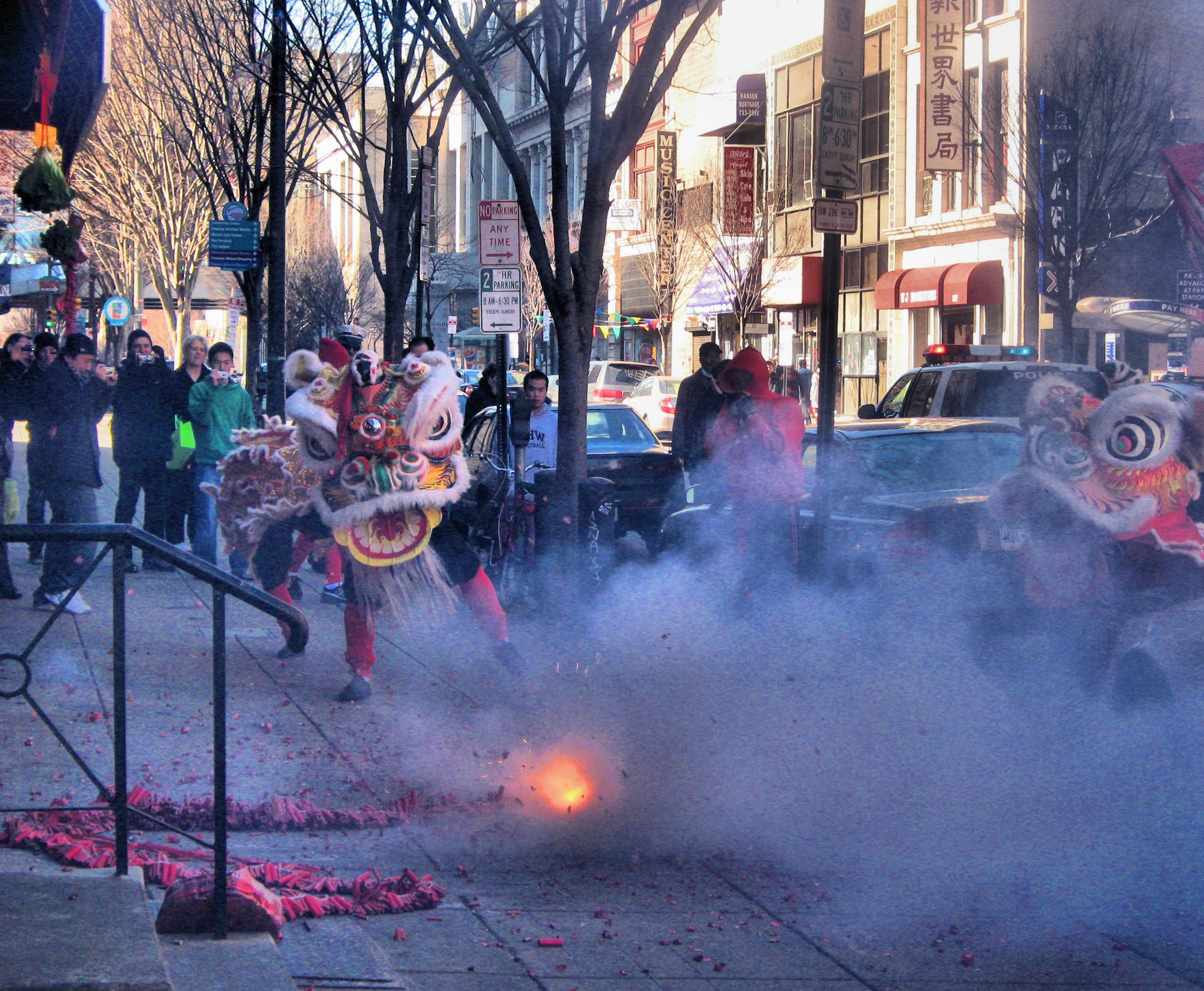

Ian Rosenzweig ’25
Tthe COVID-19 pandemic forced many limitations upon our community. When we returned to school in fall 2020, we were masked and distanced, our schedules had been adjusted, and lunch locations were scattered across the school. First, we ate in advisories. Then, in the first semester of the 2021-22 school year, Forms V and VI ate in the dining hall while Forms III and IV ate outside in the quad. As the weather worsened, Forms III and IV moved inside to the Community Room. Many of us lost the sense of community that Haverford has always provided.
As COVID-19 limitations have been eased, community life has started to return to normal. We’re unmasked, Form III is back in Centennial Hall for assemblies, and, most importantly, we are all eating together in the dining hall. Our rejuvenated ability to come together as a community has been positive; however, it has also shed light on a problem. The dining hall lacks space.
The dining hall is too crowded
COVID-19 altered many people’s outlook on hygiene ... we became increasingly aware of the space between ourselves and others.
COVID-19 altered many people’s outlook on hygiene and sanitation. We started to consciously wash our hands for 20 seconds, we sanitized as we left rooms, and we became increasingly aware of the space between ourselves and others. When we moved out of our social distancing policies, one of the most consistent of which had been the “every other seat” rule in the auditoriums, I wondered whether I had previously sat so close to people in assemblies before. I became aware of people rubbing against my elbows on the armrests and I heard people breathing next to me. That weird feeling, a
distant memory, pales by comparison to the tight, limited space of the dining hall.
On my first day eating in the dining hall since seventh grade, I had B lunch. Leaving Mr. Fifer’s Ancient World History class, I was excited to finally eat lunch without trekking from the cafeteria to the Community Room. That journey almost always involved a spilled drink or a dropped fork. I even anticipated the short lines and easy maneuverability that B lunch typically promised.
As I reached the doors to the dining hall, though, I was sorely disappointed. Before I had even reached the line, almost all of the tables were filled. I searched for my friends, finally finding a gap into which I could wedge between them. Then I needed to scan the room for a chair, which I thankfully located.
This overcrowding is a pattern as we have returned to the dining hall. Chairs are scarce. There is little room to move, and we are so unaccustomed to physical nearness that it feels like there is no clean air to breathe. Although many of us are now comfortable with being unmasked at school, we often choose to keep our distance. In the dining hall, however, it is almost impossible to maintain some level of distance.
The lack of space in the dining hall goes beyond concerns regarding COVID-19.
The pandemic instigated a new sensibility in many of us who now have heightened awareness of personal space and hygiene, and the lack of space in the cafeteria—to move, to eat, and to simply breathe freely—is not conducive to this new way of the world.


Mason Weigand ’25
We must remember the past: a reflection on a visit to New Orleans

MR. JONATHAN BACON
A cabin of the enslaved people at the Whitney Plantation; at the front, a kettle used for boiling sugarcane
Over Presidents’ Day Weekend, I traveled to New Orleans with a group of Haverford students.
One aspect of our experiences there will remain with me forever. The Whitney Plantation sits just an hour drive outside of New Orleans yet rarely gets the same attention of the lights and sounds of “The Big Easy.” Despite this, what the people there had to tell about their history was captivating.
Our time at the plantation started with us rolling out of the bus and scanning the surroundings. Unassuming fields filled with grass and marshes butted up at their edges. What I had not yet grasped was what happened on this land.
After walking in and getting our headsets for the guided tour, we stepped into the first component of our experience. The first room held images and stories about the general history of enslavement in the U.S. along with dashes of the history of the plantation we were standing on. There was some history on revolts and women and children in the slave trade. On the floor was a map of the French Quarter from the early 1800s that noted the locations of different slave markets. This was the same French Quarter we had just stood in and slept in prior to coming here. The same place with the lights, smells, and sounds that intoxicate tourists traveling to New Orleans to have a good time. Those people that walk into hotels to sleep could be resting just yards away from where families were irreparably broken as their loved ones were sold away.
Hanging from the ceiling adjacent to this room hung a canvas consisting of an image of the Louisiana law book from the time of enslavement. The laws talked about how the enslaved would be treated. One at the very bottom hit me and many others there the hardest: it described how people of any age or mental state can transfer or inherit land, but the enslaved could not. This would prevent enslaved families from gaining wealth from business passed down through generations. That law is just one in a line of many examples of gratuitous oppression the enslaved would be forced to confront. the revolt was suppressed, eighteen of the rebellion’s most prominent figures’ heads were lopped off and placed on pikes lining the most trafficked road leading into New Orleans—the same road we had just driven down to get to where we were.
After this came the Children’s Memorial and the Field of Angels. The Children’s Memorial consisted of the name of every child that died in the nearby St. John the Baptist Church. The church sits adjacent to the plantation and served both as a place of forced worship and pain for the enslaved. 2,200 children were murdered in the Church between the years 1820 and 1860. That number averages out to a child every six-and-a-half days. We saw pictures of these children and a central statue of an angel holding a newborn child.
Any somber emotions we held started to spill out into tears.
The Field of Angels built off these feelings with even more names. 107,000 different individuals’ names were etched on the walls of the memorial: the names of all the enslaved known in the history of the Louisiana slave trade. They were the names given by their masters because the ones handed to them at birth did not sound American enough, which means all we know about these people are the names that they didn’t even want. Neighboring these names were quotes from some of the enslaved that compiled over time. The one that stood out to me was one of a young boy recounting a time when another adolescent enslaved person who had escaped was recaptured in Mobile, Alabama, tied to the back of a horse, and dragged back to his plantation in Louisiana only to be buried alive.
This was not the most horrific story described.
We should never forget the sheer brutality these people endured due to the color of their skin. The experience is something that will be etched into the brains of the people on that trip and hopefully will remain with you too. This aspect of our past should not be forgotten, but that is no guarantee. These memories are mere afterthoughts to the tourists and residents of New Orleans, yet the scars of enslavement still remain today. So much has changed since then and will change after today, but we need to be the driving force in both remembering the past and directing the future in a better direction to prevent this magnitude of suffering from ever happening again.
Any somber emotions we held started to spill out into tears. We should never forget the sheer brutality these people endured due to the color of their skin.
off-campus opinions

Why you should care about redistricting
Bowen Deng ’22
Each decade, the federal government completes a census cycle to determine the distribution of the 435 seats in the United States House of Representatives. Faster growing states will gain seats, while slower-growing or declining states will lose seats. Afterward, the onus falls on state governments to redraw their Congressional Districts, and, with the 2022 midterm elections approaching, states are just wrapping up.
Ideally, adjusting or redrawing seats should accurately represent growth and decline in particular areas of each state; using Pennsylvania as an example, the State Supreme Court merged two central Pennsylvania districts–the 9th and the 12th–to reflect the stagnation of rural Pennsylvania (and Pennsylvania’s loss of one House seat), while largely maintaining the shapes of the districts around densely populated Philadelphia and its suburbs. Each state’s congressional districts should also reflect its voting pattern; in a swing state with eighteen districts, for example, it makes no sense to have thirteen districts that favor one party.
However, this is where the redistricting process turns ugly. State legislatures draw the new maps, which the governor approves or vetoes afterward. Certain laws must be followed (such as Section 2 the Voting Rights Act preventing dilution of minority voters and the Constitution preventing districts with disproportionate populations), but, when one party controls all three branches of the state legislature, partisanship often comes into play. Gerrymandering, state legislatures redrawing Congressional Districts to favor their interests, is all but too common; after an ugly 2010 redistricting cycle involving heavy gerrymandering, 2022 is looking to be no different.
Following the most recent census, Texas gained two congressional districts on account of massive population growth in the urban areas of Dallas-Fort Worth, Austin, San Antonio, and Houston; minority communities have accounted for 95% of this growth in areas that traditionally favor Democrats. The Republican-controlled Texas state legislature did draw a new, heavily-Democratic majority-minority district centered in Austin. Their new Houston-based district, however, is much uglier, connecting portions of center-city Houston with its more conservative suburbs, creating a majority-white, heavilyRepublican district. Despite the aforementioned growth, minority communities only got one Congressional district in Texas.
In redrawing their existing districts, Texas Republicans employed defensive gerrymanders. Certain suburban communities around Dallas and Houston have moved away from the GOP, allowing Democrats to flip two previously Republican seats in 2018. Texas Republicans redrew these two seats to include more urban areas–essentially a concession–allowing them to shore up other potentially vulnerable suburban Republican incumbents. Texas has long been one of the most gerrymandered states, and this redistricting cycle only reinforced that. Despite 46 percent of Texas’s electorate voting Democratic in 2020, Texas will have, at most, fourteen Democratic seats out of thirty-eight total.
On the flip side, New York State Democrats redrew their maps in an aggressive gerrymander, attempting to oust incumbent Republican seats, resulting in ugly districts winding through New York City boroughs to flip a Staten Island seat blue. Of the two Long Island seats, one was drawn into a Republican vote sink to make the other one Democratic. Simultaneously, they altered Upstate New York districts to shore up Democratic incumbents. 38 percent of New York State voters voted Republican in 2020, yet the new map would only net them four seats out of 26.
Ultimately, Texas and New York represent two sides of the same coin: partisan gerrymanders that make elections less competitive. Under the new maps of Texas and New York, there are only two competitive districts in each state, with Texas’s competitive districts favoring Republicans and New York’s favoring Democrats.
Similar efforts have happened in other states, with state legislatures drawing districts favoring their party instead of districts that represent their electorate. Competitive districts have disappeared all across the country; The Cook Political Report indicates there are only 68 Competitive Districts for the 2022 midterms, a massive decrease from the 2010 midterm elections. Factor in incumbency advantage, political climate, and demographic shifts, that number shrinks even further.
On account of a 2019 Supreme Court ruling, federal legislation preventing gerrymandering is unlikely for the foreseeable future. Still, there are other potential solutions. Colorado, Virginia, and California have adopted Independent Redistricting Commissions intended to take partisanship out of play. Some State Supreme Courts also have the power to redraw and veto gerrymanders; the North Carolina Supreme Court overturned a gerrymander and replaced it with their own, fairly drawn map.
Regardless, we all should be concerned about the partisanship involved in redistricting. While Pennsylvania’s map is fair, it only came about on account of a deadlock between the Republican state legislature and Democratic governor; both parties could not agree on district boundaries, eventually relinquishing control of the process to the State Supreme Court. We may not live in a gerrymandered district now, but that may not be the case in the future.

Pennsylvania’s Fifth Congressional District
VIA WIKIMEDIA COMMONS
Follow @haverford_index on Instagram for the latest articles right in your feed!

Olympians are humans too

Christopher Schwarting ‘24
What is the price to pay for being an athlete? Of course, there is the training, the equipment, the lessons—as one progresses, then arises the travel and the physical strain. How often, though, do we consider the mental side of sports?
The 2022 Beijing Winter Olympics concluded on February 20, 2022, amid some controversial events. In a gathering of the world’s elite athletes, there was no escaping the tension of a diplomatic boycot of the Olympics by U.S. officials amid a still-pressing pandemic. With the weight of national pressure on athletes’ shoulders, nerves and mental stress infiltrate the conscience.
This proved true at the 2022 Winter Olympics.
Amid headlines for the games were eighteen-year-old skier Eileen Gu and nineteen-year-old figure skater Zhu Yi (Beverly). Both Californian natives, the duo were part of several American-born athletes competing for China. While many embraced them, some Americans criticized the two for what they saw as a betrayal to their birth country. Chinese reception was also mixed. After winning two gold medals, Gu was transported to worldwide—and greater Chinese—stardom. Zhu, however, failed to land jumps in the women’s singles short program. Following her mistake, the hashtag #ZhuYiFellDown began trending on the Chinese media platform Weibo. Chinese criticism largely silenced support for the figure skater.
According to Reuters, Zhu reflected on her competition by saying, “I guess I felt a lot of pressure because I know everybody in China was pretty surprised with the selection for ladies’ singles and I just really wanted to show them what I was able to do, but unfortunately I didn’t.”
Not only did Zhu have to reconcile internal pressure during and after the competition, but she also had to deal with hatred and criticism. It’s likely this factored into her performance. The contrast between her reception and that of Gu reveals a clear double-standard in the reception of athletes based on their success and their ability to bring victory for their delegation.
The Russian Olympic Committee’s doping scandal that surrounded fifteen-yearold figure skater Kamila Valieva brought further controversy. Considered by some to be the best the sport has ever seen, she was the frontrunner in the women’s singles event. Her effortless attempts at quads, high-scoring hand positioning, and perfect execution were expected as she exited the women’s short program in the lead. However, after leading the Russian Olympic Committee to victory in the team event, she tested positive for a banned heart drug. Attributing the positive test to accidentally consuming her grandfather’s medication, a stance disputed by many, she was suspended by the Russian Anti-Doping Agency before having the suspension canceled. The Court of Arbitration of Sport (CAS) permitted her participation in the women’s singles event, but the International Olympic Committee (IOC) expressed its stance by threatening to postpone the medal ceremony if she placed. In her final skate program, Valieva fell multiple times, dropping out of contention for a medal. She left the ice distraught and the world in shock.
At only fifteen years old, the test shifted attention to the adults surrounding Valieva. Eteri Tutberidze, her coach, is also the coach of the gold and silver medalists in the singles event. While celebrated for her success, Tutberidze’s skaters are also known for shortened career spans and enduring abuses. It’s unlikely a fifteen-year-old willingly took drugs without the encouragement of her support team. And despite being supported by Russians upon her return home, some believe Tutberidze yelled at Valieva as she left the ice during her failed routine. Valieva was supposed to do it all: to win, to push boundaries, to set records. But the hunger for success from those around her left her with a torn mental state as a result of her final event.
All this is not to say there were no successes at the Winter Olympic games this year. The Olympics celebrate sportsmanship and athleticism—they define sport. They allow the best to assemble, push boundaries, compete, and break records. American figure skater Nathan Chen redeemed his lack of placement in 2018 to win gold in the men’s singles event while speed skater Erin Jackson became the first Black woman to win a Winter Olympic gold in speed skating. Despite three-time gold medalist and snowboarder Shaun White not leaving with the medal he wanted, he too celebrated the accomplishments of his career before retiring at the end of the games.
While many embraced the two, rejection by some Americans criticized a betrayal to their country of birth.

WIKIMEDIA COMMONS
The opening ceremony of the 2022 Beijing Winter Olympics
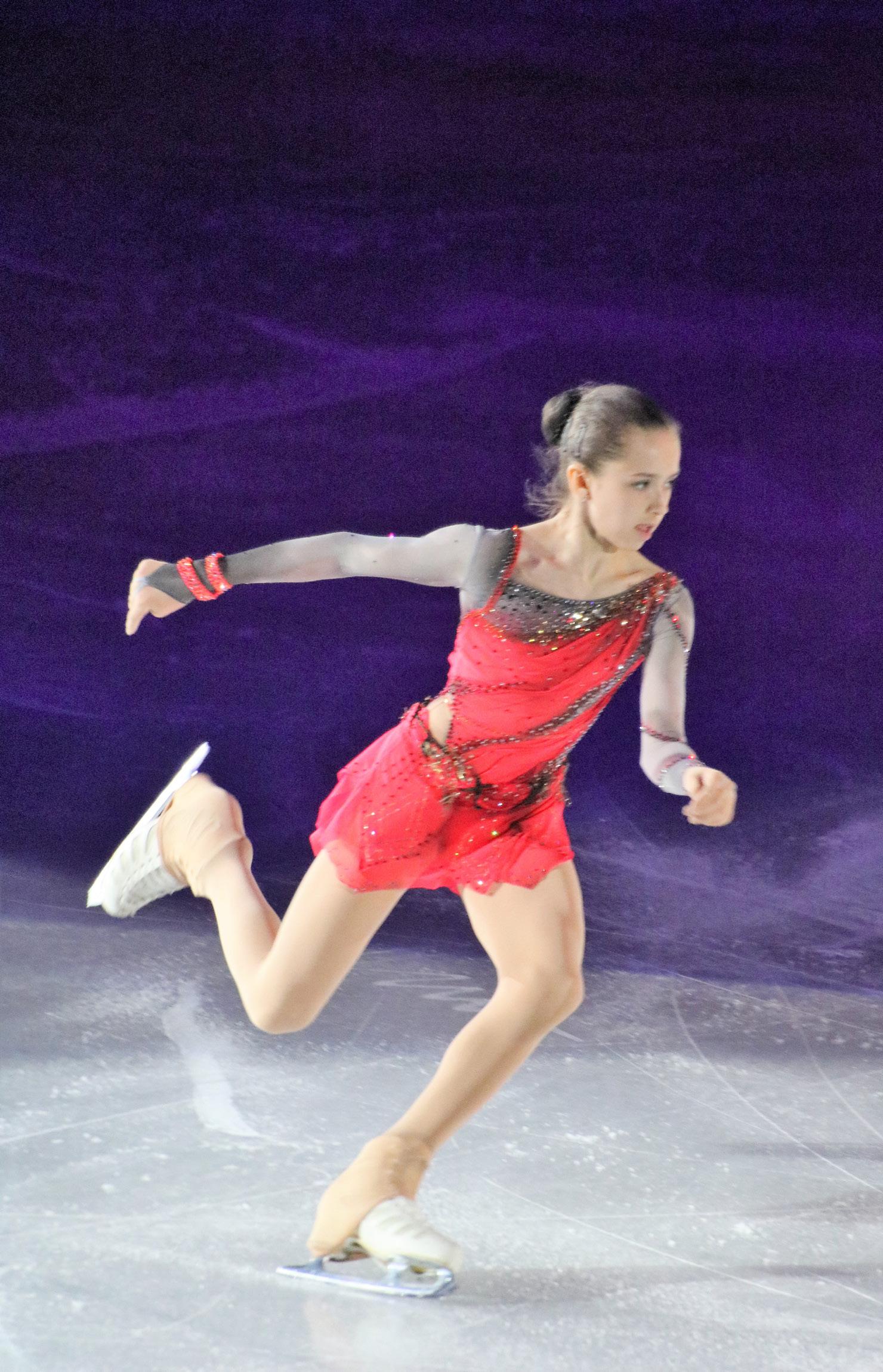
What it does mean, however, is that the athletes we view on any stage—those that we root for, bet on, and hopefully will bring home the gold for our teams—are not just competitors: they are people. They make mistakes, feel pressure, and experience criticism from coaches and the general public. To suffer the mental strain of public humiliation, in addition to the already taxing nature of being a professional athlete, is unfair to the athletes who push their limits each day. Zhu and Valieva were evaluated based on if they won gold, and when they came under the pressure of others—whether it be fans or their teams—they messed up.
It’s time we prioritize the mental health of the person who is often forgotten in every athlete.
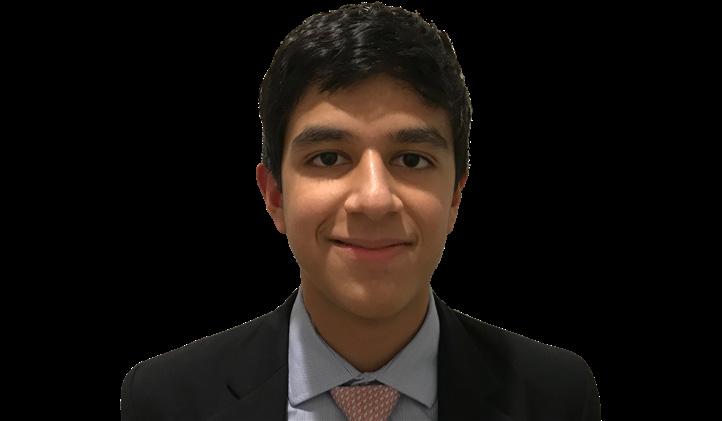
Adiyan Nayak ’24

VIA WIKIMEDIA COMMONS
The American flag flies from a vessel in the foreground as the nuclear-powered guided missile cruiser USS SOUTH CAROLINA (CGN-37) returns to port from deployment in the Persian Gulf
On August 6, 1945, the U.S. dropped the first nuclear weapon on Hiroshima, Japan. The impact alone killed at least 70,000 people, with the subsequent radiation taking another 70,000 lives. The scale of destruction was unlike anything the world had ever seen, prompting Japan to surrender shortly after the second nuclear attack.
The atomic bomb was considered a miracle creation and remarkable scientific achievement, ending a deadly war and temporarily bringing peace to the international stage. Nearly eighty years later, the possibility of nuclear warfare poses the most significant threat to the human race. In 1945, the United States possessed the only two nuclear warheads in the world. Today, there are an estimated 13,080 nuclear warheads on the planet. To say the consequences of nuclear warfare would be disastrous is an understatement; some nuclear weapons today are over 3,000 times more powerful than the atomic bomb dropped on Hiroshima.
Several studies have simulated the effects of nuclear explosions, and scientists agree that in the event of a full-scale nuclear war, the majority of the human population would perish. Nuclear winter would cause massive fallout and extreme climate change, and a global famine would eradicate the survivors. A small percentage of the species may survive to repopulate the Earth, but a nuclear war would mean the demise of the vast majority of this generation. The possibility of imminent nuclear conflict is higher than it may seem. The two countries with the most nuclear warheads, Russia (6,257) and the United States (5,550), are currently in an antagonistic relationship; tensions have only been heightened since Russia invaded Ukraine. Russian President Vladimir Putin threatened that if any country interfered, they would face consequences “unlike anything the world has ever seen.”
On March 7, the Russian government approved a list of “unfriendly countries” which included the United States, signaling a possibility of an attack. Nobody can know Putin’s psyche, but it is not unreasonable to assume that in a dire situation, he would resort to an unrestricted nuclear attack. Regardless of whether the current conflict is resolved without nuclear weapons, the threat will remain; the future will only hold more conflict, and these weapons’ sheer power will continue to grow. This raises the subject of nuclear disarmament, the reduction or elimination of nuclear weapons. Total denuclearization is the only way to ensure the safety of humanity. In theory, all the nations of the world would agree to eliminate nuclear weapons as both an offensive and defensive measure.
While an optimistic goal, the notion of total denuclearization is simply not realistic, as the nations of the world are too divided to come to such an agreement. Despite numerous efforts by the United Nations, there are currently zero nuclear disarmament negotiations taking place. There is no way to truly determine the probability of a nuclear war, as there are too many unpredictable variables that factor into the equation. However, the threat is real, and it should be treated as such. Two things are certain: this is the highest nuclear tension has been since the Cold War, and an international nuclear war is the greatest threat to our generation.

arts
Will Rubin as Nick Bottom during the show on March 13, 2022 Something Rotten! cont. from the front page
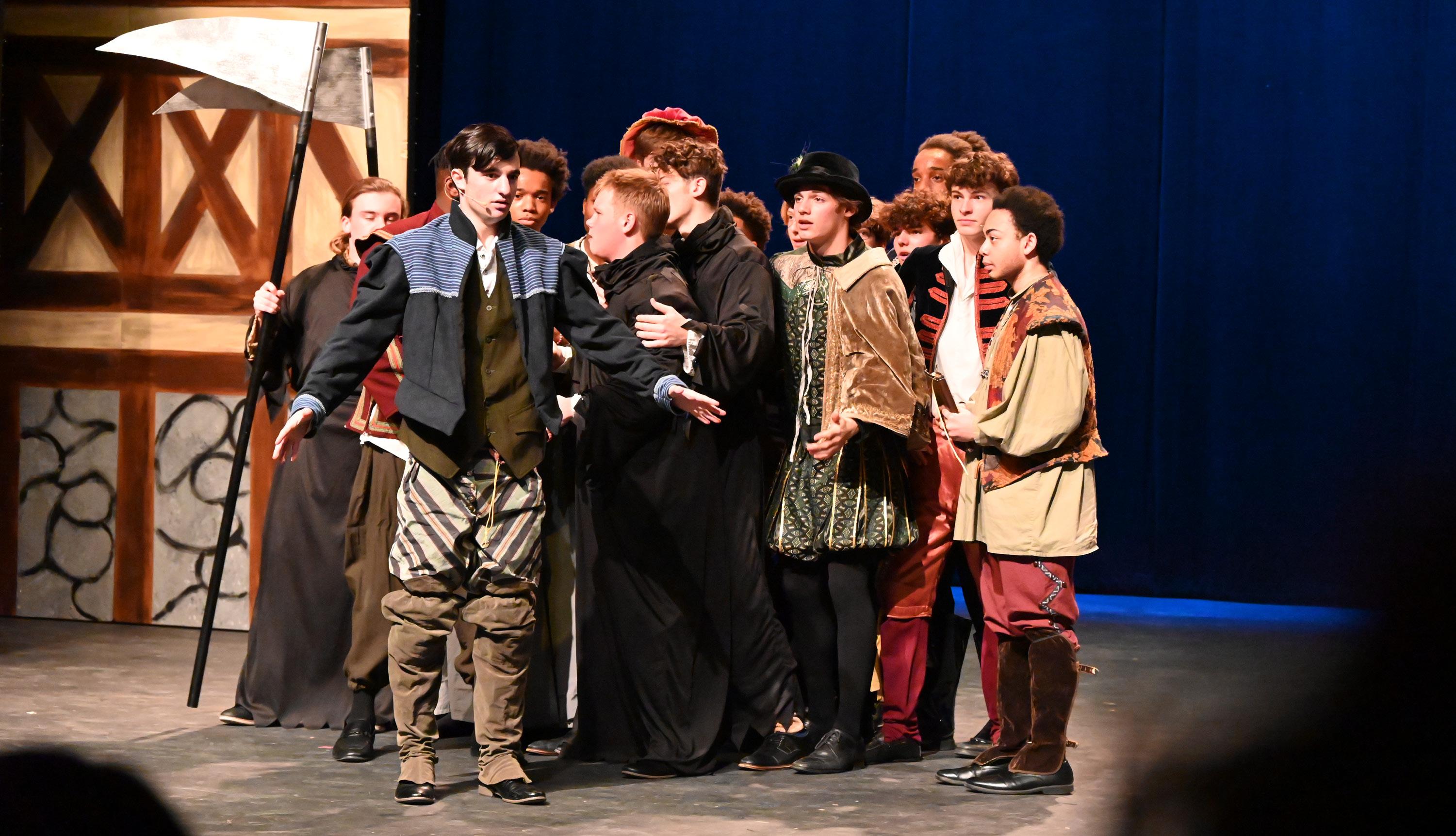
“I think the one thing that’s tough about this show, especially for Rubin, is that he has to do everything: he’s got to sing, act, and dance,” Mr. Hengst said. “Usually the leads have the songs in the scenes and the ensemble is acting, but in this one he kind of has to be a triple threat.” Rubin reflected on the character of Nick Bottom.
“The character is very focused,” Rubin said. “Nick has this laser focus on being a major success, and he’ll do anything to get it, which is why he makes the decisions he ends up making in the show. That straightforwardness, those blinders that I put on over the character, it almost punches him up.” Rubin made specific choices with his gestures and movements to step into this role. “There’s physicality to it,” Rubin said. “I like using my arms a lot and making them very straight. And I point them out because I think it shows his rigidness. Everything about him is very, very pointed. And I stayed that way off stage as well. This was the first time I tried to stay in my character off stage and get in that method acting mindset.” Pennington also studied his role as Shakespeare deeply.
“Shakespeare in this show is based on people like Freddy Mercury, Elvis Presley, and Michael Jackson—kind of a rockstar,” Pennington said. “The way I went about it was to be 100% confident. If the actor is awkward, the audience feels awkward. In our rehearsals I would play around with different interpretations to nail the character. Shakespeare really conducts the stage; he’s belittling and manipulating but he does it in a funny way. For me, it was about owning it.” Mr. Hengst described the preparations for the show as challenging but rewarding. “The process was intense,” Mr. Hengst said. “Production numbers are scenes where the entire cast is involved, and this show had the most production numbers I’ve ever done, so there was a lot of work.” The work paid off. “Mr. Hengst told us a story about one of his friends, who has seen all of the Haverford shows for the past 30 or so years,” Pennington said. “And this friend told Mr. Hengst that of all the shows, this one in particular stands out as one of the best.” “It’s been great to get back in the process,” Mr. Hengst said. “And to watch students really take off in their roles and in the show and tell a story.”
WILL RUBIN ’22

HARVEY PENNINGTON ’23
JEFFREY YANG ’22
Did you attend the spring musical?
40.2%
no
59.8%
Yes
sports
Netmen trust in fitness to conquer Inter-Ac foes
Joey Kauffman ’23
The tennis team knows a thing or two about winning. Coming off of eleven straight Inter-Ac titles, the team is filled with talented underclassmen. They are ready to compete.
“I’d love to win another Inter-Ac title. Make it twelve in a row. That’s my main goal, especially as a senior about to graduate high school,” Sixth Form co-captain Damian Ferraro said.
Still, Ferraro wants to win another title for the right reasons.
“But my biggest thing is to have a team with amazing chemistry and make that chemistry be the reason why we won our twelfth Inter-Ac,” Ferraro said. “Just have a great group of guys that I can look to whenever I need to beyond just tennis.”
Fostering team culture is of utmost importance to the team, which has a great number of talented underclassmen and even a Second Former playing for the team.
“We just have a lot of talent coming in from the underclassmen. Everyone’s really committed, and everyone really seems to love playing tennis,” Sixth Former Will Rubin said.
To create that team atmosphere, Ferraro focuses on bringing underclassmen into the team culture.
“Last year we had a very close team and we had a lot of close chemistry. So at this point we’re kind of just building on that chemistry and bringing in the other kids,” Ferraro said.
The upperclassmen make distinct efforts to integrate the younger kids.
“I remember last year when I was a junior, I would always try and go out of my way to include the sophomores, and the seniors above me would try to do the same with me,” Rubin said. “I just think it promotes a really really great team culture.”
This effort appears to be working, as team members report a high level of camaraderie.
“We’re all just boys, you know what I’m saying? We’re all mates,” Fifth Former Arnav Sardesai said.
At one practice, the team was about to start playing matches, but it started raining, and they couldn’t use the courts. Not knowing whether or not to go back to Haverford or stay at the courts because of the rain, the team decided to start doing pull-ups on the tennis gate.
“So everyone just started designating people to do pull-ups,” Ferraro said. “By the time we decided we were going to condition on the wet courts, most of the kids had done a couple pull-ups.”
It may be the excitement and levity with which the players approach working out that will allow the team to achieve their goal of being “the fittest team in the Inter-Ac.”
“We’re just a really well-connected team, and Coach [Antonio] Fink makes sure that we’re the fittest team in the Inter-Ac. So, that’s really important,” Sardesai said.
Fitness can be the factor that makes or breaks a match for some players.
“It’s important for us, especially singles players, just to get that fitness down, that endurance, because once you get to the third set, the final tie break, it’s not even about your technique at that point, it’s really about your mental strength and how fit you are, if you can last on the court. So whoever can last as long as possible essentially wins,” Fifth Former Ethan Chan said.
Team members also focus on the mental aspect of the game.
“I think sometimes I can let the game get the best of me, and I can really just fall into a place where I’m playing matches where I’m just not my best,” Fifth Former Joaquin Arias said. “I think that’s one of my main focuses as well—just get stronger mentally.”
DAMIAN FERRARO
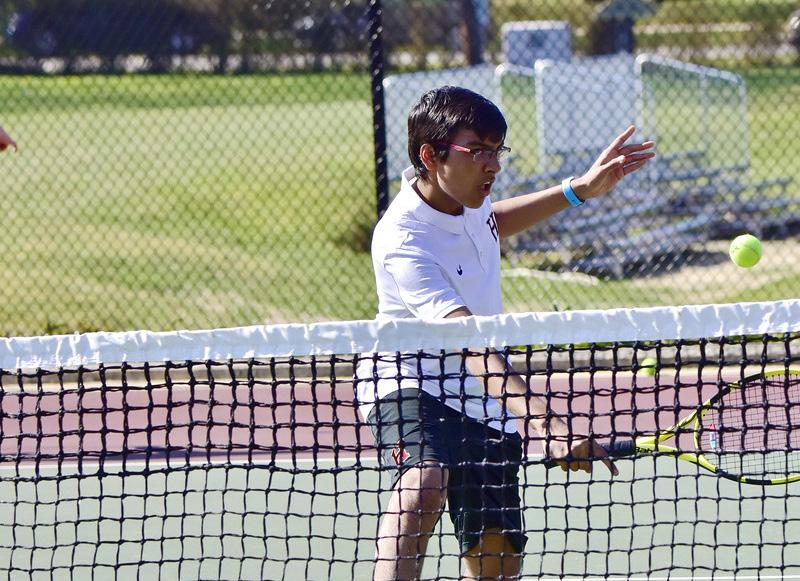
COMMUNICATIONS
Adamya Aggarwal ’22 in a match against the Lawrenceville School
ARNAV SARDESAI
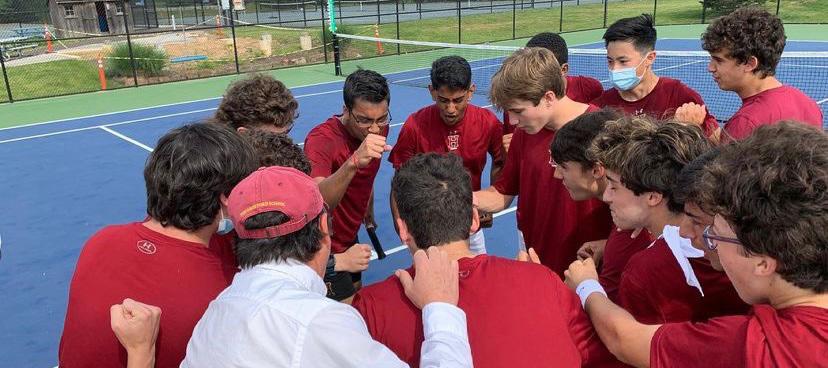
around
the corner

March 17 20 22 24
Varsity baseball plays a home game against Germantown Friends’ School at 4:00 p.m.
JV and Varsity Crew spend all day at Boathouse Row on Kelly drive for the first race of the season, Many Flick 1
Varsity lacrosse plays against St. Sebastian’s at the second home game of the lacrosse season at 4:00 p.m.
Spring break begins and will last for 11 days. GO FORDS!




